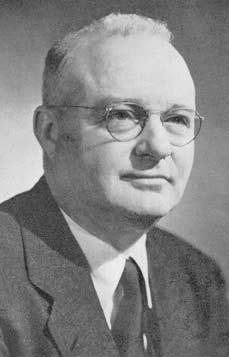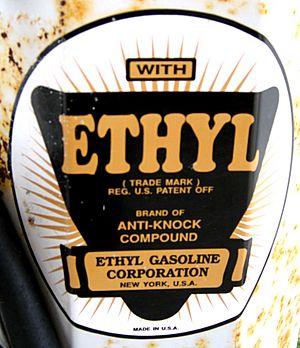Thomas Midgley Jr. facts for kids
Quick facts for kids
Thomas Midgley Jr.
|
|
|---|---|

Midgley c. 1930s–1940s
|
|
| Born | May 18, 1889 |
| Died | November 2, 1944 (aged 55) Worthington, Ohio, U.S.
|
| Alma mater | Cornell University |
| Known for |
|
| Spouse(s) |
Carrie Reynolds
(m. 1911) |
| Awards |
|
| Scientific career | |
| Fields |
|
Thomas Midgley Jr. (born May 18, 1889 – died November 2, 1944) was an American engineer. He worked in both mechanical and chemical engineering. He is known for helping to create leaded gasoline and some of the first chlorofluorocarbons (CFCs). CFCs were also known by the brand name Freon. Both of these products were later stopped from being used widely. This was because they caused harm to people's health and the environment. During his career, Midgley received over 100 patents for his inventions.
In 1940, Midgley got polio, which made him unable to move easily. He died in 1944. Many people believe his inventions had a big negative impact on the environment. One historian, J. R. McNeill, said Midgley "had more adverse impact on the atmosphere than any other single organism in Earth's history."
Contents
Early Life and Education
Thomas Midgley Jr. was born in Beaver Falls, Pennsylvania. His birthday was May 18, 1889. His parents were Hattie Louise and Thomas Midgley Sr. His family had a history of inventing things. His father invented parts for car tires. His grandfather, James Emerson, invented a special kind of saw.
Thomas Jr. grew up in Columbus, Ohio. He went to Cornell University. In 1911, he earned a degree in mechanical engineering.
Career Highlights
Developing Leaded Gasoline
In 1916, Midgley started working for General Motors. In 1921, he made an important discovery. He was working with Charles F. Kettering at a General Motors lab. Midgley found that adding tetraethyllead (TEL) to gasoline stopped engines from "knocking." Engine knocking is a loud noise that happens when fuel burns unevenly.
The company called this new substance "Ethyl." They did not mention the word "lead" in their ads. Oil and car companies promoted TEL. They said it was cheaper and better than other fuels like ethanol. In 1922, Midgley received the Nichols Medal for his work on anti-knock compounds. This was the first of many awards he would receive.
In 1923, Midgley took a break from work. He had been exposed to lead and needed to recover. He said his lungs were affected. General Motors then created a new company, GMCC. This company was to make TEL. Midgley became a vice president there.
However, making TEL was dangerous. Workers at the plants became very sick. Some even died from lead exposure. The risks of lead were known for a long time. Benjamin Franklin had written about lead poisoning years before. Midgley himself knew the dangers. He tried to show that TEL was safe. In 1924, he poured TEL on his hands at a press conference. He also breathed its vapor. He claimed it was safe.
Despite this, a plant in New Jersey was closed due to worker illnesses. Production started again in 1926. Leaded gasoline became very popular. It was especially important for military vehicles. However, the long-term effects of lead on the environment were not fully understood then.
Creating Freon
In the late 1920s, air conditioning and refrigeration systems used different chemicals. These chemicals included ammonia and sulfur dioxide. While they worked, they were often toxic, flammable, or could explode. Frigidaire, a part of General Motors, wanted a safer option. They needed a chemical that was not toxic or flammable.
Midgley and his colleague, Albert Leon Henne, started looking for new chemicals. They focused on compounds that contained carbon and halogens. These chemicals were known to evaporate easily, which is good for refrigerants. They decided to add fluorine to a hydrocarbon. They believed the strong bond between carbon and fluorine would make the chemical safe.
They created dichlorodifluoromethane. This was the first chlorofluorocarbon (CFC). They named it "Freon". Today, it is often called "Freon 12" or "R12".
Freon and other CFCs quickly became widely used. They replaced older, more dangerous refrigerants. CFCs were also used in other products. For example, they were used as propellants in aerosol sprays and asthma inhalers. Midgley received more awards for this work. He got the Perkin Medal in 1937 and the Priestley Medal in 1941. He was also elected to the United States National Academy of Sciences. In 1944, he became the president of the American Chemical Society.
Later Life and Death
In 1940, when he was 51, Thomas Midgley Jr. got polio. This illness left him very disabled. He created a special system of ropes and pulleys. This system helped him lift himself out of bed.
On November 2, 1944, Midgley was found dead at his home. He was 55 years old. He had become tangled in his own device and died. He was survived by his wife, Carrie M. Reynolds, whom he had married in 1911.
Lasting Impact
Thomas Midgley's inventions, leaded gasoline and freon, had a significant negative impact on the environment.
The leaded gasoline he helped create released large amounts of lead into the air. High levels of lead in the air have been linked to serious health problems. These problems include issues with brain development in children. They are also linked to increased violence in some areas. Time magazine later listed both leaded gasoline and CFCs as "The 50 Worst Inventions."
Midgley died before people fully understood the problems with CFCs. It was later discovered that CFCs damage the ozone layer. The ozone layer protects Earth from harmful sun rays. CFCs also act as greenhouse gases, which contribute to climate change. In 1987, an international agreement called the Montreal Protocol was signed. This agreement aimed to stop the use of CFCs like Freon.
Images for kids
See also
 In Spanish: Thomas Midgley para niños
In Spanish: Thomas Midgley para niños




